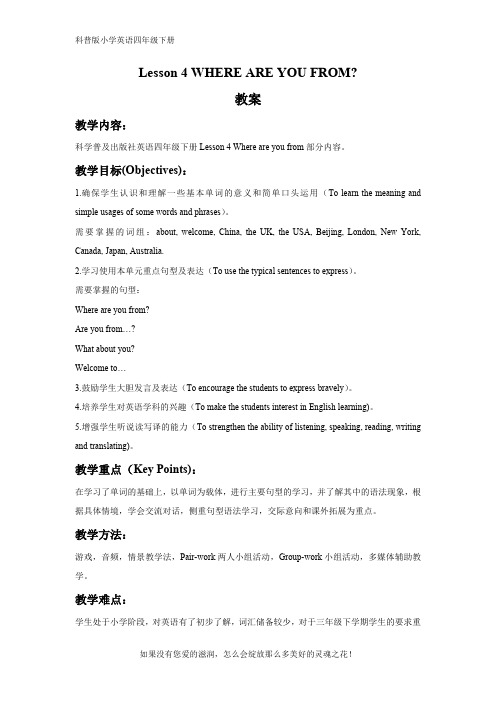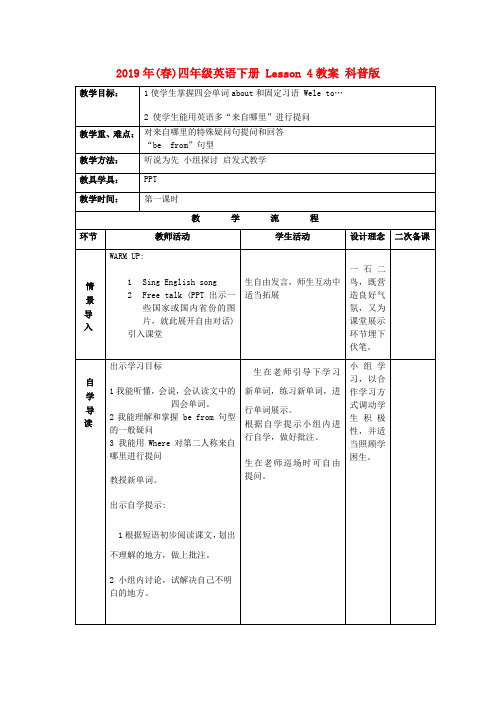科普版小学英语四年级下册【精品系列】Lesson 4教学设计
- 格式:pdf
- 大小:112.88 KB
- 文档页数:4

Lesson 4 WHERE ARE YOU FROM?教案教学内容:科学普及出版社英语四年级下册Lesson 4 Where are you from部分内容。
教学目标(Objectives):1.确保学生认识和理解一些基本单词的意义和简单口头运用(To learn the meaning and simple usages of some words and phrases)。
需要掌握的词组:about, welcome, China, the UK, the USA, Beijing, London, New York, Canada, Japan, Australia.2.学习使用本单元重点句型及表达(To use the typical sentences to express)。
需要掌握的句型:Where are you from?Are you from…?What about you?Welcome to…3.鼓励学生大胆发言及表达(To encourage the students to express bravely)。
4.培养学生对英语学科的兴趣(To make the students interest in English learning)。
5.增强学生听说读写译的能力(To strengthen the ability of listening, speaking, reading, writing and translating)。
教学重点(Key Points):在学习了单词的基础上,以单词为载体,进行主要句型的学习,并了解其中的语法现象,根据具体情境,学会交流对话,侧重句型语法学习,交际意向和课外拓展为重点。
教学方法:游戏,音频,情景教学法,Pair-work两人小组活动,Group-work小组活动,多媒体辅助教学。
教学难点:学生处于小学阶段,对英语有了初步了解,词汇储备较少,对于三年级下学期学生的要求重点是在会读会说的基础上,能掌握一些基本单词的拼写和造句,了解一定的语法内涵,与人进行简单沟通交流。

![四年级-科普版-英语-下册-[教学设计]-Lesson-4-(Let’s-learn)](https://img.taocdn.com/s1/m/df0b07776fdb6f1aff00bed5b9f3f90f76c64dcf.png)
Lesson 4 Where are you from?Let’s learn一、教学目标1. 知识目标:(1) 学生能够听懂会说认读国家和城市的单词;(2) 并能熟练运用本课句型进行对话。
2. 能力目标:能运用句型“Where are you from?”“I’m from…/We’re from…”就国籍进行问答。
3. 情感目标:(1) 培养学生认真听,积极参与,乐于交流的学习态度。
(2) 在熟练之后,可以与同伴自由对话。
二、教学重点掌握和运用句型“Where are you from?” “Are you from…?”三、教学难点认读本课表示国家和城市的单词。
四、教学方法讲读法、直观演示法、表演法、愉快教学相结合五、教学准备单词卡片、多媒体课件、图片六、教学过程Step I Warm-upGreeting and sing a song.T: Hello, boys and girls. Nice to meet you. Today, we’re going to have a new lesson. First, l et’s sing a song, OK? (Fishes, fishes, where are you?)【设计意图】在音乐中活跃气氛,学生身心得到放松,积极主动投入,并为学新课做铺垫。
Step II Presentation1.(1) 出示一张中国地图,引出省,市,城市的英语的表示方法。
T: 在这张地图上,有我国的许多省,市,和城市,如何用英语表示这些地名呢?比如:北京就用汉语拼音写Beijing。
那么请同学们自己写写山东,四川,上海,江西,云南。
教师带读并说:I like Shanghai. Because a man.(2) 借助于幻灯片,学习本课的句型:Where are you from?T: Who is he?S: He’s Yaoming.T: Where are you from?(听录音,看句子)I’m from Shanghai.师问:谁能说说句子的意思?在学生了解后,说明be from的意思并带读。

一、教案:Unit 1 Our School1. Teaching objectives:(1) Students can understand and use the key words and sentence patterns about school subjects and school things. (2) Students can listen, speak, read and write about school subjects and school things.(3) Students can develop good learning habits and cooperate with others.2. Teaching key and difficult points:(1) Master the pronunciation and meaning of the new words about school subjects and school things.(2) Understand and use the sentence pattern "What do you learn? I learn" and "What do you have? I have"3. Teaching procedures:Step 1: Warm-up and review(1) Review the previous learned words and sentences.(2) Lead-in: Show pictures of school subjects and ask students what they learn.Step 2: Presentation(1) Teacher presents the new words and sentences about school subjects and school things.(2) Students listen, repeat and imitate the words andsentences.Step 3: Practice(1) Students practice the sentences with their partners.(2) Teacher asks students to answer questions about their school subjects and school things.Step 4: Consolidation(1) Students write a short passage about their school subjects and school things.(2) Teacher selects some students to read their passages.4. Homework:(1) Copy the new words and sentences.(2) Practice speaking and writing about their school subjects and school things.二、教案:Unit 2 My Classroom1. Teaching objectives:(1) Students can understand and use the key words and sentence patterns about the classroom.(2) Students can listen, speak, read and write about the classroom.(3) Students can learn to observe and describe the environment.2. Teaching key and difficult points:(1) Master the pronunciation and meaning of the new words about the classroom.(2) Understand and use the sentence pattern "What's in the classroom? There are"3. Teaching procedures:Step 1: Warm-up and review(1) Review the previous learned words and sentences.(2) Lead-in: Show pictures of classrooms and ask students what they see.Step 2: Presentation(1) Teacher presents the new words and sentences about the classroom.(2) Students listen, repeat and imitate the words and sentences.Step 3: Practice(1) Students practice the sentences with their partners.(2) Teacher asks students to describe the classrooms they see in pictures.Step 4: Consolidation(1) Students write a short passage about their classrooms.(2) Teacher selects some students to read their passages.4. Homework:(1) Copy the new words and sentences.(2) Practice speaking and writing about their classrooms.三、教案:Unit 3 My Teacher1. Teaching objectives:(1) Students can understand and use the key words and sentence patterns about teachers.(2) Students can listen, speak, read and write about teachers.(3) Students can respect and appreciate teachers.2. Teaching key and difficult points:(1) Master the pronunciation and meaning of the new words about teachers.(2) Understand and use the sentence pattern "What does your teacher look like? She/He looks like"3. Teaching procedures:Step 1: Warm-up and review(1) Review the previous learned words and sentences.(2) Lead-in: Show pictures of teachers and ask students what they think of their teachers.Step 2: Presentation(1) Teacher presents the new words and sentences about teachers.(2) Students listen, repeat and imitate the words andsentences.Step 3: Practice(1) Students practice the sentences with their partners.(2) Teacher asks students to describe their teachers. Step 4: Consolidation(1) Students write a short passage about their teachers.(2) Teacher selects some students to read their passages.4. Homework:(1) Copy the new words and sentences.(2) Practice speaking and writing about their teachers.四、教案:Unit 4 My Schoolbag1. Teaching objectives:(1) Students can understand and六、教案:Unit 6 In My Room1. 教学目标:(1) 学生能够理解和使用关于房间内的关键单词和句子结构。


四年级下册英语教案Lesson 4 Where are you from 第一课时科普版(三起)教学内容本课为科普版(三起)四年级下册英语的第四课,主题为“Where are you from”。
教学内容主要包括询问及回答来自何处,学习有关国家和城市的英语表达,以及运用这些表达进行简单的对话交流。
教学目标1. 能听懂、会说、会读本节课的重点词汇和句型:“Where are you from? I'm from”。
2. 能够运用所学句型和词汇询问他人来自哪里,并能够介绍自己的来源地。
3. 增进对不同国家和城市的认识,培养跨文化交际意识。
教学难点1. 正确发音和使用本课的重点词汇和句型。
2. 理解并运用“Where are you from? I'm from”进行有效对话。
3. 记忆并识别不同国家和城市的英文名称。
教具学具准备1. 多媒体教学设备,用于播放课件和视频。
2. 地图或国旗卡片,用于展示不同国家和城市的地理位置和标志。
3. 学生手册和练习册,用于课堂练习和课后作业。
4. 彩色粉笔,用于板书设计。
教学过程第一阶段:导入通过展示地球仪或世界地图,引导学生谈论他们所知道的国家和城市。
提问:“Do you know where some famous cities are located?”,让学生分享他们的知识。
第二阶段:新课呈现使用课件展示本课的句型和词汇,让学生跟读并模仿发音。
通过角色扮演活动,让学生练习“Where are you from? I'm from”的对话。
第三阶段:互动练习分组进行对话练习,鼓励学生使用所学句型和词汇询问彼此的来源地。
教师巡回指导,纠正发音和用法错误。
第四阶段:巩固提升设计一个“猜猜我是哪里人”的游戏,让学生通过提问猜出对方的来源地。
通过多媒体展示不同国家和城市的图片,让学生快速识别并说出它们的英文名称。
邀请学生分享他们的学习感受和收获。
教案四年级下英语教案Lesson 4 Are these elephants科普版教学内容:本课为科普版四年级下册英语第四课,主要围绕动物词汇展开,学习如何描述动物的外貌和特征。
教学内容包括动物词汇的学习、描述动物句型的运用以及相关语法知识。
教学目标:1. 学生能够听懂、会说、会读本课的动物词汇,如elephant, lion, tiger等。
2. 学生能够运用所学句型描述动物的外貌和特征,如"These are elephants. They are big and have long trunks."3. 学生能够理解并运用一般现在时态来描述动物的特征。
教学难点:1. 动物词汇的发音和记忆。
2. 描述动物句型的运用和语法规则的掌握。
教具学具准备:1. 动物卡片或图片。
2. 黑板或白板。
3. 教学PPT或投影仪。
教学过程:1. 导入:通过展示一些动物的图片或卡片,引导学生回顾已学的动物词汇,并引入本课的主题。
2. 呈现:向学生展示本课的动物词汇,并通过图片或实物来帮助学生理解和记忆。
同时,引导学生运用所学句型描述动物的外貌和特征。
3. 练习:通过小组活动或角色扮演等方式,让学生练习描述动物。
教师可以提供一些动物图片或卡片,让学生分组进行练习,并互相交流。
4. 应用:通过一些活动或游戏,让学生运用所学知识进行实际应用。
例如,可以让学生扮演动物的角色,用所学句型描述自己的外貌和特征。
板书设计:1. 在黑板上列出本课的动物词汇,并附上相应的图片或卡片。
作业设计:1. 让学生回家后,用所学句型描述一些动物的外貌和特征,并写下来。
2. 准备一些与本课相关的练习题,让学生巩固所学知识。
课后反思:通过本课的教学,我发现在动物词汇的学习和描述动物的句型运用方面,学生还存在一些困难。
在今后的教学中,我需要更加注重学生的口语表达能力和语法规则的掌握,提供更多的练习机会和反馈指导,帮助学生更好地理解和运用所学知识。
四年级英语教案古槐三小Lesson 1 Are you in Grade Four ?教学目标:1. 能听懂.会说.会认读way, they, behind, new, table.并能根据中文拼写出英文.2. 能听懂.会说交际用语,并能用来进行对话.教学重难点:1. 词汇.2. 交际用语.教具准备:录音机.教学过程:第1课时一. 学习单词:教师把本课要求掌握的8个生词写在黑板上,教师领读几遍,让学生自己读,直到熟练为止.二.学习Let’s talk :本课的对话可以用自问自答导入法导入,教师可同时充当Jill, Bill和Lulu 三个角色,先站在右边充当Jill 和Bill ,说”Excuse me , .please.” 再转到左边充当Lulu ,说” Yes ?” ,再转回右边充当Jill和Bill 说” We are new . We can’t find our classroom.” 一直到将全段对话表演完,表演两遍后放录音,先将全段放一遍,然后逐句放,让学生逐句跟说并翻译成中文.三. 操练:将对话分成三段, 各配一幅简笔画,教师写出关键词,然后逐段操练.操练的顺序是:先让学生听录音并跟说两遍,再让他们连起来说,并给他们半分钟时间让他们根据关键词复述,然后让全班复述.在三段都操练完毕后,让同座间充当不同角色进行对话,一人充当Bill,另一人充当Lulu, 三段连起来练习,最后叫若干对同学站起来复述全段对话,然后将学生按三人一组分组,要求他们在下一堂课上进行表演.四.作业:让学生课下练习,准备下节课进行表演.五. 效果测试:根据Let’s talk.的内容填空A: Excuse ( ) , please.B: Yes ?A: We are ( ).We can’t find our ( ).B: Are you in ( ) Four ?A: Yes , we ( ).B: What class are you ( )A: We’re in ( ) Three .B: Class Three ? This ( ) , please .第2课时一. 复习检查:1.复习生词:复习上课时所学的8个生词,其中要求四会的五个词可由教师说中文,让学生写出英文,其余三个只要求三会的词,可由教师说英文,让学生写出中文.2.本课对话:先放一遍录音,然后按上一课时布置的分组,叫若干组学生站起来表演对话.二. 导入新课:1.复习和学习生词.先复习已学过的单词class , grade ,classroom 等,教师可说中文”三班”.”五年级”. 等,让学生说英文,再从<<活动资料>>中取出reading room 和 classroom 等的简笔画,边画边读单词.然后由教师说reading room 等,让学生举图,再由教师举图,由学生英文.2.导入主题句型:本课的主题句型有两个,即”Are they in Grade Four ? Yes, they are ./No, they aren’t .”和What grade are they in ? They are in Grade Four . 本课只列入了后一句型,但学习是这两个句型都要练.教师可将主题句写在黑板上,并出示挂图或简笔画,然后指图自问自答,说过几遍后略作解释,说明当主语为复数的we, you, they时,系动词用are.最后再指图逐句说,并将主语改为we 和You再说几遍,让学生逐句跟说.三. 操练:让同座的同学指着书上的图互相问答,在哪个班级或年级可由学生自己随便说.最后叫若干组学生到黑板前,指着黑板上的图互相问答.四.Let’s sing :学唱歌曲.由于没有什么生词,很容易学会.五.效果测试:根据要求变换句式:1.I’m in Grade Three . (变为一般疑问句,并做肯定和否定回答)2.They are in Class Two . (对画线部分提问)3.We are in Grade Four .(变为否定句)第3课时一.复习检查:1、复习单词.2、自由对话:叫若干同学站起来,用以前学过的交际用语自由对话.二. 导入新课:1. 复习单词:教师说以下单词:find, gradema, box, help, clock, bed, nose, 让学生说出中文词义.2、导入:可采用图片导入法或简笔画情景教学法导入,教师出示教学挂图或简笔画,并在下面写上关键词,然后放录音,先从头到尾放一到两遍,再逐句放,让学生重复并译为中文. 三. 操练:逐图放录音,先让学生逐句重复,然后让他们连起来说,再给半分钟让他们自己朗读,再让全班集体朗读几遍,然后叫四五名学生站起来朗读.全部操练完毕后,可从头到尾连起来朗读.四. Listen and tick :如果学生反应较快,可以只放一遍录音,如果反应不太快可以放两遍录音.注意每题间暂听几秒钟,让学生思考和答题.五. 效果测试:根据短文内容回答问题:1.Who can’t find her glasses ?2.Are the glasses in the box ?3Who helps Grandma ?4.Are the glasses on the table ?5.Are the glasses behind the clock ?6.Are the glasses under the bed ?7.Who find the glasses ?8.Where are the glasses ?Lesson 2 Are you from American?教学目标:1、进一步复习和掌握短元音音素,长元音音素和双元音音素,并了解哪些字母和字母组合读这些音。
小学英语科普版四年级下册《Lesson 4 Where are you from?》优质课教案省级比赛获奖教案公开课教师面试试讲教案【名师授课教案】1教学目标1、熟练运用句型----Where are you from?----I’m from…进行问答。
2、能听懂、会说、会读、会认单词Italy、Egypt、Australia、Brazil、Iceland、France 6个单词。
3、能听懂、会说句型1) ---- Is he /she from ... ?----Yes, he is . / No ,she isn’t.2) ----Where is he /she from?---- He /she is from…并能用来进行对话。
2重点难点教学重点:会用句型1) ---- Is he /she from ... ?----Yes, he is . / No ,she isn’t.2) ----Where is he /she from?---- He /she is from…进行对话。
教学难点:Italy、Egypt、Australia、Brazil等单词的发音,特别是重读。
3教学过程教学活动1【导入】一、复习RevisionT:Good morning ,everyone.Now,I have a picture to show you.(出示世界地图)T:What’s this ?Ss :It’s a map .T: Yeah , it’s a world map. Here ,look(T放大地图,显示China部分,并用手指住),th e People’s Republic of China .I am from China. Where are you from ?。
Lesson 4
Where are you from?
【知识目标】
1.学会本课中的四会及三会单词和短语。
2.学习并掌握用Where…be from提问某人来自于哪里,并做出正确回答。
3.理解并会朗读短文。
【能力目标】
发展学生综合运用语言的能力,培养学生自主探究的能力及与同学的分工合作的能力。
【情感目标】
激发学生学习热情与参与欲望,能够大胆开口,主动模仿,调动学习积极性。
通过课文的学
习,让学生学增强民族团结意识,培养爱国主义情感。
【教学重点】
学习用Where…be from
提问某人来自于哪里,并做出正确回答。
【教学难点】
创设语言情境,运用Where…be from 句型。
Tape recorder, Multimedia Step1. Warm-up
Ask the students to talk about the ID cards
What’s his name?
He is Wei Xiaobao.
Where is he from?
He is from China.
What’s his name?
He is Ao Bama.
Where is he from?
He is from America.
Step 2. Presentation
1.Talk about the picture on page20, learn the conversation. Focus on the key words and structures.
2. Play the recording, read and repeat the conversations on page 20.
Step 3. Drills
1. Play the recording , do the part of “Listen and match”.
2. Play the recording , do the part of “Match and say”.
Step 4. Practice
1.Play the recording , listen and talk the conversations on Page23, then answer some questions.
(1). Who is Li Shan’s e-pal?
Wei Gang.
(2). Is Wei Gang from Anhui?
Yes, he is.
(3). Where is Li Shan from?
He is from Hunan.
2.Play it again and ask the students to repeat.
Step 5. Games
Read the story on Page24, understand the story. First finish the conversation. Then ask the students to act it out in groups.
Step 6. Summary
1. Read and repeat the key words.
2. Go through the key structures.
Step 7 Homework
1. Recite the conversations on Page20.
2. Write conversations according to the pictures on Page21.
略。